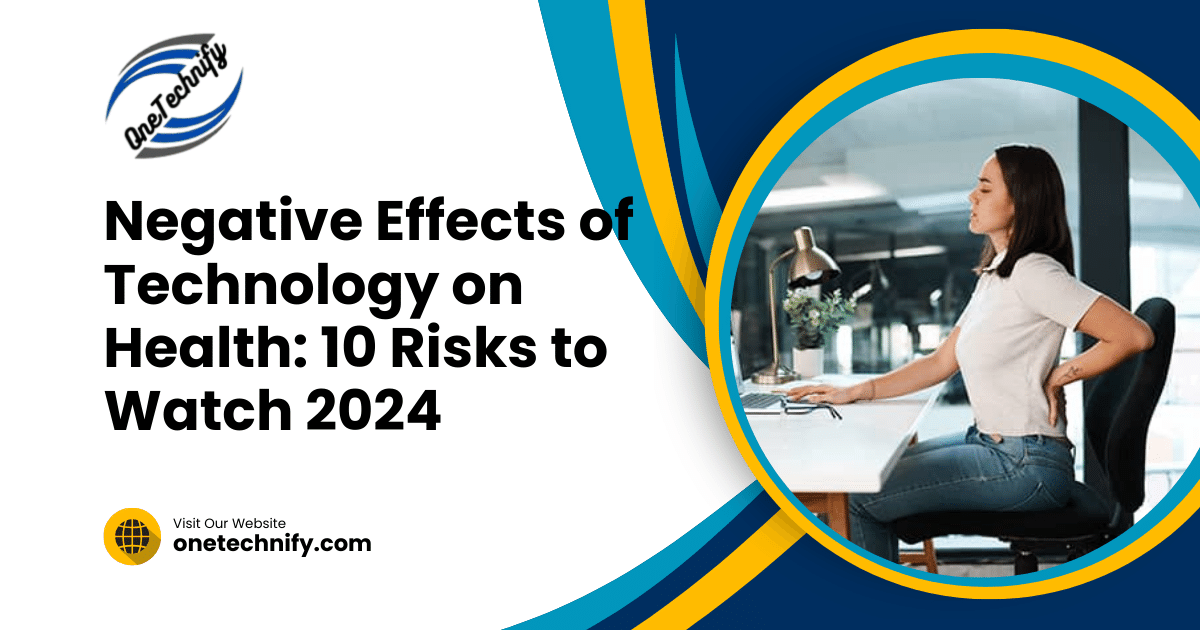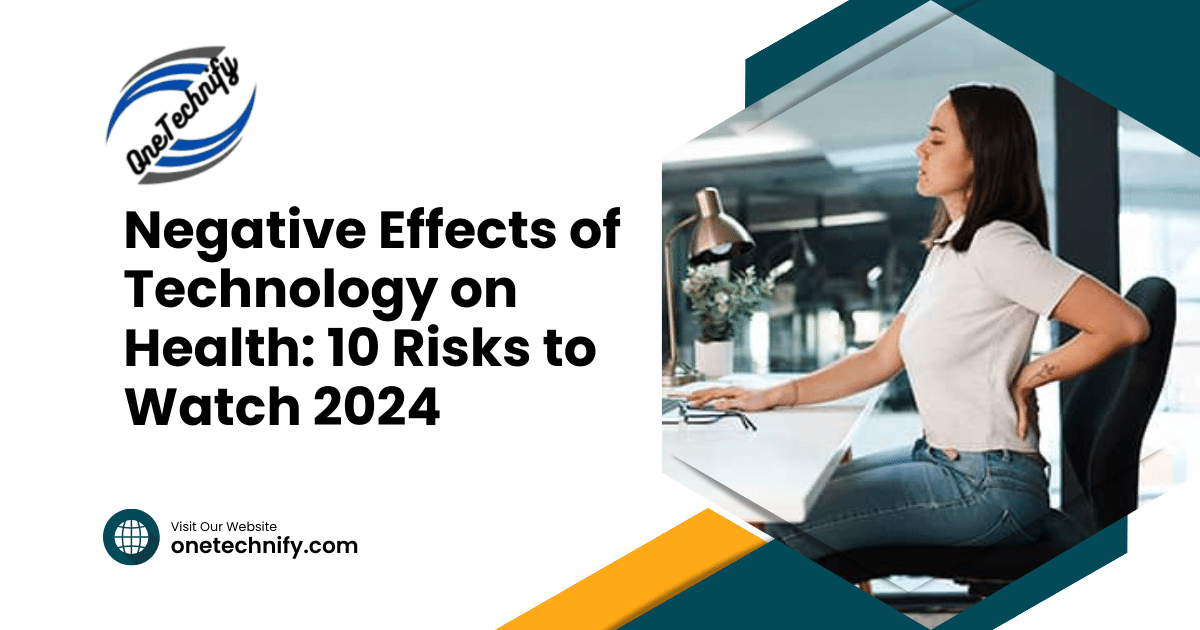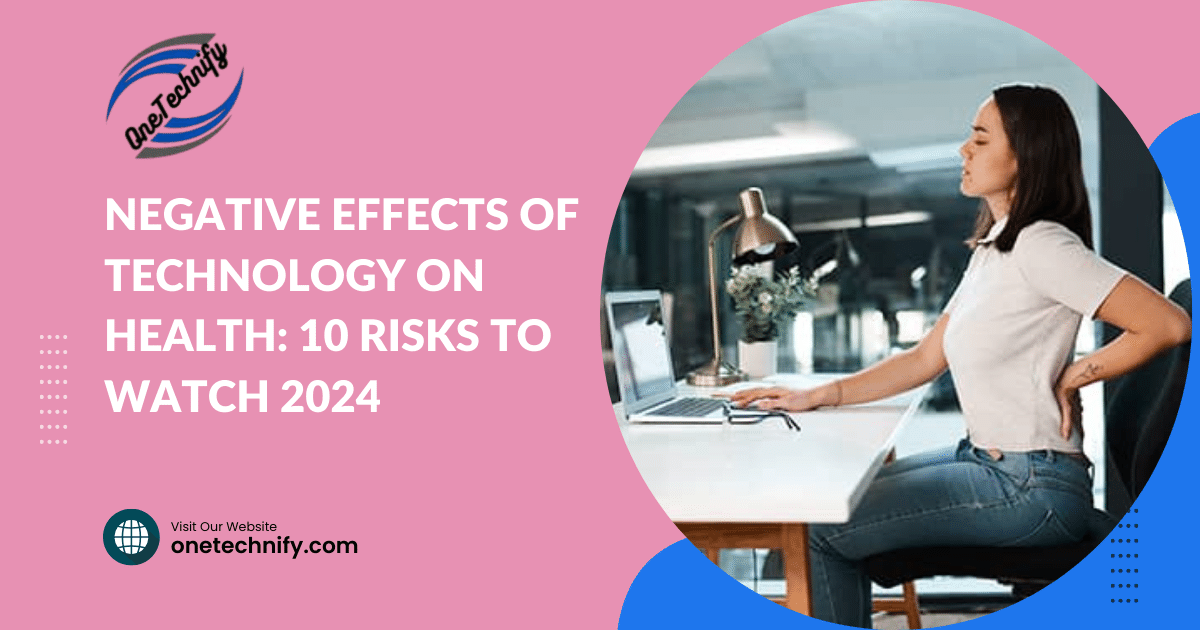In today’s digital age, technology has woven itself into every aspect of our lives. However, this constant connectivity comes at a cost. From eyestrain to disrupted sleep patterns and sedentary lifestyles, the negative effects of technology on health are profound. In this listicle, we delve into these detrimental effects, their negative impact, and provide insights on how to mitigate them.
Discover how excessive screen time can wreak havoc on your eyesight and attention span, learn about the dangers of tech-induced sleep disturbances, and uncover the hidden risks associated with a predominantly sedentary, tech-driven lifestyle. Stay tuned as we unravel the adverse effects of technology on health, including eyestrain, and explore strategies to safeguard your well-being in an increasingly digital world.
Table of Contents
Increased Risk of Obesity
Excessive screen time often leads to a sedentary lifestyle, where children spend prolonged hours sitting while using technology. This lack of neural activity can contribute to weight gain and an increased risk of obesity over time.
Moreover, the habit of consuming unhealthy snacks while engaging with technology is prevalent. People, students, tend to mindlessly eat high-calorie foods like chips or sweets when they are engrossed in their screens, which can further exacerbate weight-related issues.
The combination of reduced physical activation and poor dietary choices due to technology usage creates a perfect storm for obesity. Without proper exercise and nutrition, the body tends to store excess calories as fat, leading to potential health complications associated with being overweight.
To combat these negative effects on health, it’s crucial for students to be mindful of their screen time and incorporate regular breaks for physical activity. Encouraging healthier snack options and setting limits on sedentary behaviors can also help mitigate the risks associated with obesity in the digital age.
Reduced Physical Activity
Technology has replaced traditional outdoor activities and exercise among students, leading to a decline in physical exercise. With increased screen time, students and people in a group are more sedentary, which can have adverse effects on health. The distractions caused by technology often result in decreased motivation for engaging in physical activities.
This shift towards a more inactive lifestyle can impact overall well-being. Lack of physical activity is linked to various health issues like obesity, heart disease, and mental health disorders. It’s crucial to find a balance between technology use and engaging in physical exercise to maintain optimal health.
Incorporating small changes like taking short breaks from screens to stretch or going for walks can help combat the negative effects of reduced physical activity due to technology. Setting limits on screen time for both adults and children is essential in promoting an active lifestyle. By being mindful of how technology affects our daily routines, we can make conscious efforts to prioritize physical activity and improve our overall health.
Poor Posture and Back Pain
Frequent use of smartphones and tablets can lead to neck strain as users often bend their heads forward while looking at screens. This constant downward head tilt places significant pressure on the neck muscles, potentially causing discomfort and pain.
Sitting for prolonged periods in front of screens, whether for work or leisure, is a common contributor to back pain. The lack of movement and poor posture during extended screen time can strain the back muscles, leading to stiffness and discomfort over time.
Improper ergonomics when using technology devices can result in poor posture, exacerbating back issues. Slouching or hunching over while using laptops or computers can put undue stress on the spine, contributing to long-term postural problems that may manifest as chronic back pain.
To mitigate these negative effects on posture and back health caused by technology use:
- Ensure your screen is at eye level to reduce neck strain.
- Take regular breaks to stretch and move around.
- Invest in ergonomic furniture like chairs with proper lumbar support.
Sleep Disorders
Blue light emitted by screens can disrupt sleep patterns, affecting the body’s production of melatonin, a hormone that regulates sleep. This disruption leads to difficulty falling asleep and can result in poor sleep quality.
Increased exposure to stimulating content before bed can further exacerbate sleep issues. Engaging with exciting or stressful information close to bedtime stimulates the brain, making it harder for individuals to relax and fall asleep naturally.

Dependence on technology often leads to late-night usage, contributing to sleep deprivation. The constant availability of entertainment or work-related activities on devices encourages individuals to stay up later than intended, sacrificing crucial hours of rest.
Studies have shown that excessive screen time before bed is linked to various symptoms related to disrupted sleep patterns and insomnia. These symptoms include difficulty initiating or maintaining sleep, waking up frequently during the night, and experiencing non-restorative or poor-quality sleep.
To combat these negative effects on health caused by technology use before bedtime, experts recommend establishing a digital curfew at least an hour before sleeping. This practice helps reduce exposure to blue light and stimulating content, promoting better overall sleep hygiene.
Digital Eye Strain
Extended screen time can lead to eye fatigue and dryness, affecting individuals who spend prolonged hours on digital devices. Without regular breaks, staring at screens may result in blurred vision due to the constant strain on the eyes. The blue light emitted by electronic devices is a significant contributor to eye strain and discomfort experienced by many.
Research indicates that up to 50% of computer users experience symptoms of digital eye strain, highlighting the widespread impact of excessive screen exposure. Symptoms such as headaches, neck pain, and difficulty focusing are commonly associated with this condition. To alleviate digital eye strain, experts recommend following the 20-20-20 rule: every 20 minutes, take a 20-second break to look at something 20 feet away.
Moreover, investing in blue light blocking glasses or using software applications that reduce blue light emission from screens can help mitigate the effects of prolonged screen time on eye health. By incorporating these simple strategies into daily routines, individuals can minimize the negative impact of technology on their visual well-being.
Hearing Loss from Headphones
Prolonged use of headphones at high volumes can damage your hearing. The delicate structures in the inner ear are sensitive and can be harmed by continuous exposure to loud sounds.
Frequent exposure to loud music or media through earphones is a common cause of hearing loss. Research shows that listening to music above 85 decibels for prolonged periods can lead to irreversible damage over time.
Failure to take breaks from headphone usage may result in auditory damage. It’s essential to give your ears rest between listening sessions, especially when using headphones at high volumes.
Remember, protecting your hearing is crucial for overall health and well-being. Be mindful of volume levels and duration when using headphones to prevent long-term consequences on your auditory health.
Mental Health Issues
Excessive use of social media can worsen feelings of depression and anxiety. Constant exposure to curated online personas can lead individuals to compare their lives negatively, resulting in low self-esteem. This phenomenon is particularly common among younger demographics who are more susceptible to the effects of social media on mental well-being.
Moreover, cyberbullying and online harassment have become prevalent issues that significantly impact psychological health. Victims often experience heightened levels of stress and fear due to the continuous negative interactions they face. The anonymity provided by the internet sometimes emboldens individuals to engage in harmful behaviors they wouldn’t exhibit in person.
Research indicates a strong correlation between excessive screen time and mental health disorders, emphasizing the need for moderation when using technology. Creating a healthy balance between digital engagement and real-world interactions is crucial for maintaining positive psychological well-being.
In today’s digitally savvy society, it’s essential for individuals, especially young people who are still developing emotionally, to be mindful of their online activities’ impact on their mental health. Seeking support from professionals or engaging in offline hobbies can help mitigate the adverse effects technology may have on one’s psychological state.
Social Isolation
Excessive technology use can lead to social isolation by replacing face-to-face interactions with digital communication. This shift diminishes opportunities for meaningful connections and reduces the development of essential social skills.
Individuals who rely heavily on technology may find themselves feeling disconnected from real-life relationships. The lack of in-person interactions can result in a sense of loneliness and detachment from the nuances of human behavior that are only apparent during face-to-face encounters.

Moreover, constant exposure to screens can create a barrier to forming genuine connections with others. People immersed in technology often struggle with maintaining deep, fulfilling relationships as they become accustomed to shallow online interactions.
In today’s digital age, it is crucial to strike a balance between utilizing technology for convenience and ensuring that it does not hinder our ability to engage meaningfully with those around us. Prioritizing face-to-face communication and limiting screen time can help combat social isolation and nurture authentic human connections.
Addiction to Digital Devices
Excessive use of digital devices can lead to a compulsive need for constant access, affecting daily life functioning. Individuals may struggle to control the amount of time spent on technology, leading to neglect of responsibilities and relationships.
This addiction can manifest in various ways:
- Compulsive Behavior: Constantly checking smartphones or other devices.
- Social Withdrawal: Preferring screen time over social interactions.
- Impact on Health: Disrupted sleep patterns and increased sedentary behavior.
Studies show that this addiction is not only prevalent among adults but also increasingly common among children. The instant gratification provided by technology, such as texting or using apps, contributes to shorter attention spans and difficulty focusing on tasks.
Moreover, the allure of multitasking with multiple screens or activities can hinder cognitive abilities like reading comprehension. This continuous exposure to stimuli from technology throughout the day can make it challenging for individuals to unwind at the end of the day with a book or other relaxing activities.
Recognizing these signs early on and implementing strategies for healthy technology use is crucial in mitigating the negative effects associated with excessive screen time.
Exposure to Harmful Radiation
Prolonged exposure to electromagnetic radiation from technology devices poses potential health risks. Research suggests a correlation between long-term radiation exposure and an increased risk of cancer. Despite limited studies on the long-term effects, concerns about the impact of device radiation persist.
Experts warn that continuous use of devices emitting electromagnetic fields can lead to adverse health effects over time. The World Health Organization (WHO) has classified this type of radiation as possibly carcinogenic to humans, further emphasizing the need for caution in technology usage.
Although more research is needed to fully understand the extent of harm caused by device radiation, taking preventive measures like limiting screen time and using protective accessories can help mitigate potential risks associated with prolonged exposure.
Final Remarks on Negative Effects of Technology on Health
You’ve now seen the myriad ways technology can impact your health negatively. From obesity to sleep disorders, poor posture to social isolation, the effects are vast and profound. It’s crucial to be mindful of your tech usage and its consequences on your well-being.

Take charge of your health by setting boundaries with technology, incorporating regular breaks, and prioritizing physical activity. Remember, moderation is key. Stay informed about the potential risks and make conscious choices to safeguard your health in this digital age.
Frequently Asked Questions
How does technology contribute to an increased risk of obesity?
Technology promotes sedentary behaviors like prolonged sitting and snacking while using devices, leading to reduced physical activity levels. Excessive screen time may disrupt eating patterns and increase the consumption of unhealthy foods, contributing to weight gain.
What are some common mental health issues associated with technology use?
Excessive use of technology can lead to anxiety, depression, stress, and sleep disturbances. Constant exposure to social media can trigger feelings of inadequacy or FOMO (fear of missing out), impacting self-esteem negatively.
Can spending too much time on digital devices cause sleep disorders?
Yes, excessive screen time before bed can interfere with the production of melatonin—a hormone that regulates sleep-wake cycles—leading to difficulty falling asleep or poor-quality sleep. The blue light emitted by screens suppresses melatonin production, disrupting the body’s natural circadian rhythm.
How does prolonged use of technology affect posture and back pain?
Continuous use of devices often leads to poor posture habits such as slouching or craning the neck forward. This places strain on the spine and muscles in the neck and back, causing discomfort and potentially leading to chronic issues like musculoskeletal pain.
Is social isolation a common consequence of heavy reliance on digital devices?
Excessive screen time can replace face-to-face interactions, reducing meaningful social connections. This lack of real-world engagement may result in feelings of loneliness and isolation over time as individuals prioritize virtual relationships over in-person interactions.






